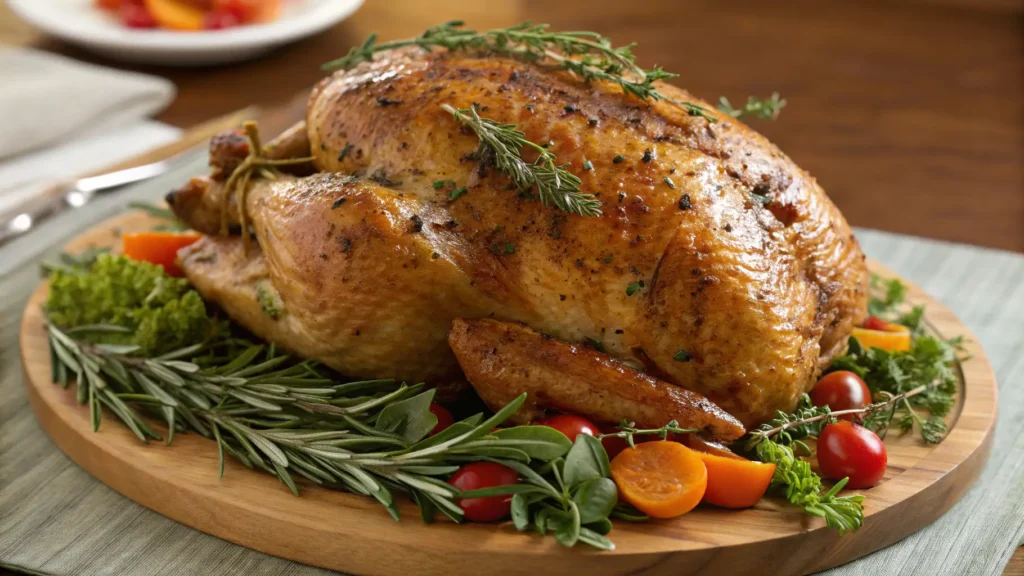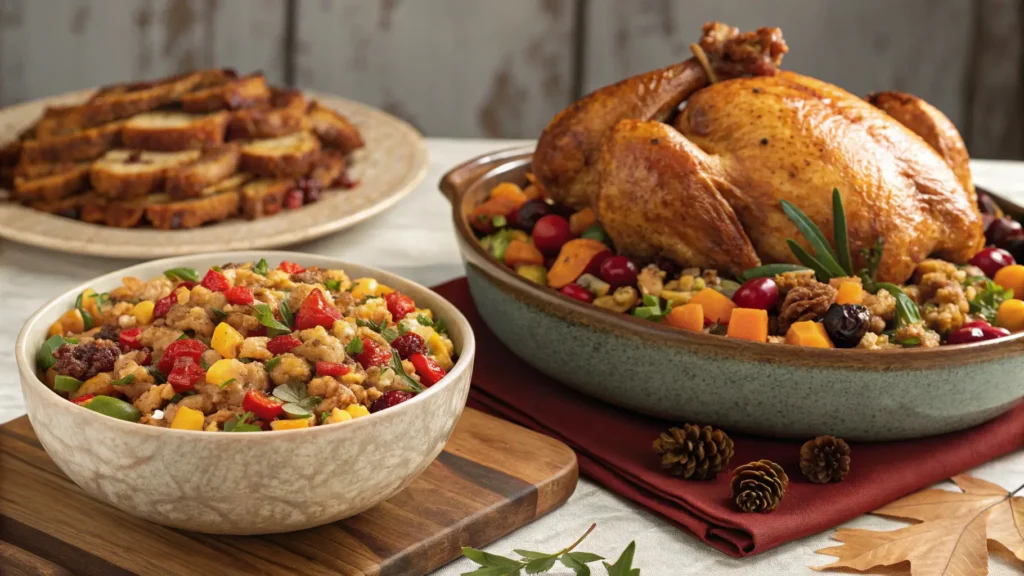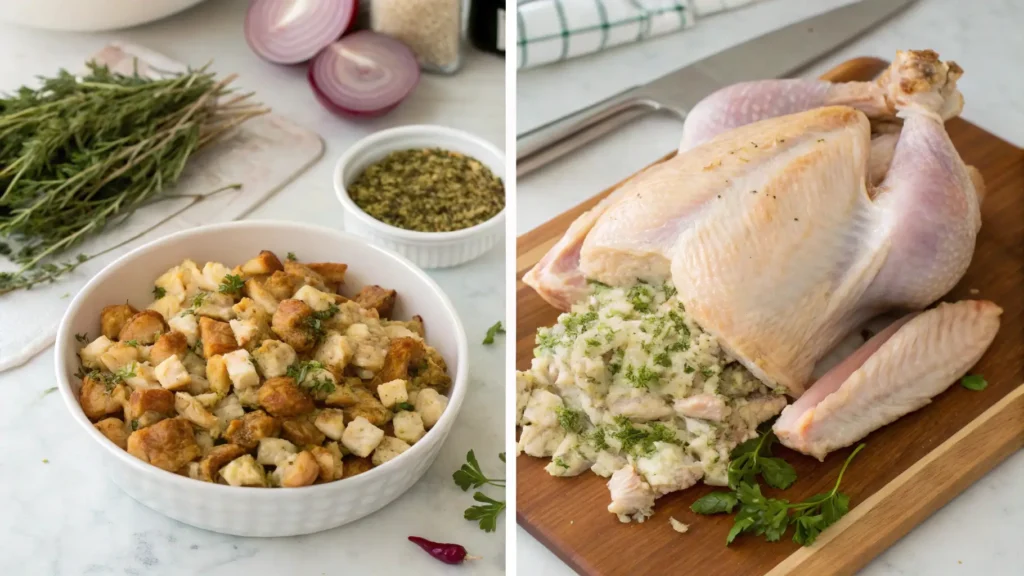Thanksgiving dinner isn’t just about the turkey; it’s about the flavor-packed centerpiece that steals the show. If you’ve ever wondered what is best to stuff a turkey with for flavor, this guide is for you. From aromatic vegetables and fresh herbs to unconventional stuffing ideas, we’ll walk you through options to make your turkey unforgettable. This article covers essential ingredients, creative alternatives, and tips to ensure your turkey is both flavorful and safe. Let’s dive in!

Understanding the Basics of Turkey Stuffing
What Is Turkey Stuffing?
Turkey stuffing, also called dressing, refers to a mixture of ingredients cooked either inside the cavity of the turkey or separately. Traditionally, it consists of bread cubes mixed with vegetables, herbs, and broth, but modern variations are vast. Stuffing not only adds moisture to the meat but also creates an opportunity to infuse the turkey with irresistible flavor.
Stuffing serves two purposes: enhancing the bird’s taste and providing a complementary side dish. Whether you cook it inside or out, getting the right blend of ingredients is key to a flavorful turkey.
Traditional vs. Modern Turkey Stuffing Options
For centuries, cooks have relied on classic combinations like onion, celery, and sage, paired with bread or grains, to stuff their turkeys. These staples create a savory and comforting taste that’s hard to beat. However, contemporary cooks are exploring innovative ingredients such as quinoa, dried fruits, and even international spices to give the turkey a unique twist.
The debate over whether stuffing is better inside the turkey or baked separately has its pros and cons. Stuffing inside absorbs turkey juices for deeper flavor but may require additional attention to cooking times for safety. Baking it in a dish allows for a crispier texture and easier preparation. Whichever route you choose, flavor is king.
Key Ingredients to Add Flavor to Turkey Stuffing
When asking what is best to stuff a turkey with for flavor, the answer often lies in a balance of ingredients that bring out the best in your bird. Aromatic vegetables, fresh herbs, and other tasty elements can transform an ordinary turkey into a feast bursting with flavor. Here’s a closer look at the essentials.
Aromatic Vegetables: Onions, Celery, and Carrots
Aromatic vegetables are the backbone of a flavorful stuffing. Onions, celery, and carrots are classic choices that bring a natural sweetness and depth of flavor. These ingredients, often referred to as a “mirepoix,” create a savory base that pairs perfectly with turkey. Dice them finely so they cook evenly, releasing their aromatic essence into the stuffing and the turkey itself.
Adding garlic to the mix can amplify the flavor even more. Its pungent, savory notes work well with both traditional and modern stuffing recipes, making it a versatile addition.
Herbs for a Fresh Flavor Profile: Rosemary, Thyme, and Sage
Herbs are another crucial component when considering what is best to stuff a turkey with for flavor. Fresh rosemary, thyme, and sage deliver a fragrant and earthy aroma that screams Thanksgiving. These herbs not only enhance the stuffing but also infuse the turkey with their essence as the juices circulate during cooking.
For an extra kick, consider adding parsley or chives for a lighter, brighter note. Chop the herbs finely to ensure even distribution throughout the stuffing.
Fruits for Sweetness: Apples, Oranges, and Cranberries
Fruits like apples, oranges, and cranberries bring a touch of sweetness that beautifully complements the savory elements of stuffing. Apples add moisture and a subtle tartness, while orange slices introduce a citrusy zing. Cranberries, whether fresh or dried, provide a pop of color and a sweet-tart flavor that enhances the turkey’s overall profile.
Place fruit slices or pieces strategically within the stuffing for a mix of textures and flavors.
Savory Elements: Garlic, Mushrooms, and Bacon
For those who love a hearty stuffing, savory ingredients like mushrooms and bacon are game-changers. Mushrooms add an earthy richness, while crispy bacon provides a smoky, salty bite. Combining these with other classic ingredients creates a multi-layered flavor profile that elevates the dish.
Mix in cooked sausage or pancetta for even more depth. However, be cautious not to overpower the delicate flavor of the turkey itself.
Non-Traditional Stuffing Ideas for Bold Flavors

If you’re ready to break away from tradition, there are plenty of creative ideas for stuffing your turkey. These non-traditional options answer what is best to stuff a turkey with for flavor when you’re seeking something bold and different.
Bread-Free Options: Quinoa, Rice, and Wild Grains
For a healthier alternative, bread-free stuffing is a fantastic choice. Quinoa, rice, and wild grains create a nutty, chewy base that absorbs flavor beautifully. Cook the grains beforehand, then mix them with your favorite aromatics, herbs, and vegetables. Wild rice, for instance, adds a delightful chewiness and pairs wonderfully with dried cranberries and nuts.
These options are perfect for gluten-free guests or anyone looking for a lighter stuffing.
International Flavors: Spices Like Cumin, Paprika, and Turmeric
Spices inspired by global cuisines can bring an unexpected twist to your turkey. Cumin, paprika, and turmeric create warm, earthy flavors reminiscent of Mediterranean and Middle Eastern dishes. Mix these spices with couscous or lentils for a stuffing that packs a punch.
Another idea? Try adding curry powder or chili flakes for a spicy kick that’s sure to impress adventurous eaters.
Vegetarian and Vegan Stuffing Ideas
For those embracing a plant-based lifestyle, vegetarian and vegan stuffing options are plentiful. Replace butter with olive oil and use vegetable broth instead of chicken stock. Stuff your turkey cavity with a mix of roasted vegetables, nuts, and cranberries for a hearty and satisfying dish.
Portobello mushrooms, chestnuts, and even tofu crumbles can serve as a base for vegan-friendly stuffing, delivering rich flavors without the need for animal products.
By exploring these bold and creative options, you can take your turkey to the next level, whether sticking to tradition or venturing into new culinary territory. Up next: tips for stuffing your turkey safely and effectively!
Tips for Safe and Flavorful Turkey Stuffing
Stuffing a turkey can elevate its flavor, but safety is just as important as taste. If you’re exploring what is best to stuff a turkey with for flavor, knowing the proper techniques ensures your feast is both delicious and safe to eat. Follow these tips to achieve the perfect balance.
How to Safely Cook Stuffed Turkey to Avoid Drying Out
Cooking a stuffed turkey can be tricky because the stuffing needs to reach an internal temperature of 165°F to be safe for consumption. Use a meat thermometer to check the turkey and the stuffing separately. To prevent the turkey from drying out while ensuring the stuffing is fully cooked, cover the bird with foil during the initial stages of roasting, then uncover it toward the end for a golden-brown finish.
If you’re pressed for time or concerned about even cooking, you can bake the stuffing separately. This method ensures both the turkey and stuffing are cooked to perfection.
Tips for Prepping Ingredients for Maximum Flavor
Prepping the right way is crucial when deciding what is best to stuff a turkey with for flavor. Start by sautéing your aromatics like onions, garlic, and celery to deepen their flavors before adding them to the mix. Use fresh herbs wherever possible, as they release a more vibrant aroma compared to dried ones.
Consider toasting any nuts or breadcrumbs in your stuffing to enhance their flavor and add a slight crunch. When adding fruits or juices like orange slices, ensure they’re evenly distributed to prevent any one flavor from overpowering the rest.
Suggestion: For more turkey preparation tips, you might enjoy reading How to Get Flavor Into Turkey Breast for additional insights on enhancing your holiday meal.
Step-by-Step Guide to Stuffing a Turkey

Now that you’ve gathered all your ingredients, it’s time to bring it all together. This simple guide will help you confidently stuff your turkey and answer what is best to stuff a turkey with for flavor with a hands-on approach.
How Much Stuffing to Use Per Pound of Turkey
A good rule of thumb is to use about ¾ cup of stuffing per pound of turkey. Overstuffing can lead to uneven cooking, so err on the side of caution. If you have extra stuffing, bake it separately in a casserole dish.
Arranging Ingredients for Even Cooking
To ensure even cooking, loosely fill the turkey cavity with your chosen stuffing mixture. Packing it too tightly prevents heat from circulating, which can cause undercooking. Start by placing a layer of herbs, like rosemary or thyme, directly in the cavity to infuse the turkey with aromatic flavor. Then, add your main stuffing mix, making sure to leave some room for the steam to circulate.
After stuffing, tie the turkey’s legs together to keep the cavity closed and help the bird cook evenly.
With these steps, your turkey will not only taste incredible but also leave your guests raving. Ready for more? Check out Tangle Recipes for additional holiday cooking inspiration!
FAQs: Common Questions About Turkey Stuffing
What is best to stuff a turkey with for flavor?
Aromatic vegetables, fresh herbs, and a touch of fruit are classic choices, while non-traditional options like quinoa or international spices can add unique flavors.
Can I stuff the turkey the night before?
No, it’s not recommended. Stuffing the turkey ahead of time increases the risk of bacterial growth. Always prepare and stuff the bird right before cooking.
What herbs work best in turkey stuffing?
Classic herbs like rosemary, thyme, and sage are popular choices. For a fresher twist, add parsley or chives.
Is stuffing better inside or outside the turkey?
Stuffing inside absorbs more flavor from the turkey but takes longer to cook. Baking it outside offers a crispier texture and less hassle.
Final Thoughts
Stuffing a turkey can be a fun and rewarding process that takes your meal to the next level. By following these tips and avoiding common mistakes, you’ll create a dish that’s both safe and packed with flavor. Whether you’re sticking to tradition or experimenting with new ideas, finding what is best to stuff a turkey with for flavor will make all the difference.

